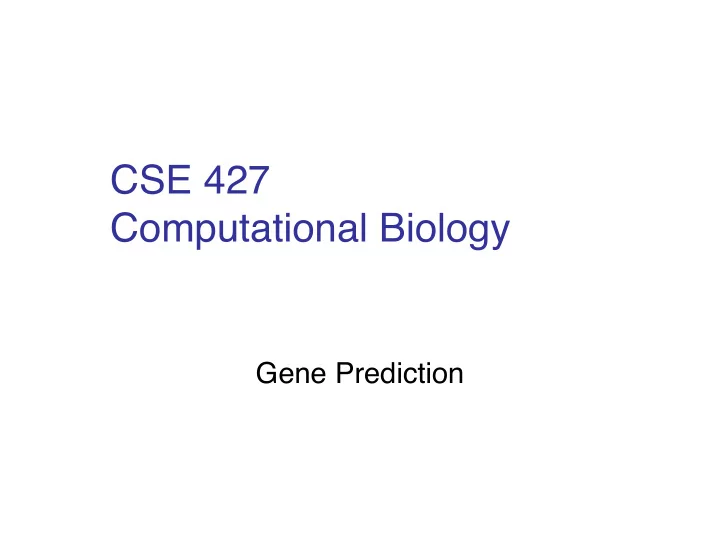

CSE 427 Computational Biology Gene Prediction
A statistical interlude: Fair or biased? H H H H T H H T T H 3
More likely fair or biased? H H H H T H H T T H 4
More likely H0 or H1? H H H H T H H T T H H0: .5 – .5 H1: .9 – .1 5
Quantify likelihood: H 0 vs H 1 H H H H T H H T T H H0: .5 – .5 .5^10 H1: .9 – .1 .9^7 * .1^3 Likelihood ratio: (.5^10)/(.9^7 * .1^3) = .4898 (I.e., odds favor “biased” by about 2:1) 6
Gene Finding: Motivation Sequence data flooding into Genbank What does it mean? protein genes, RNA genes, mitochondria, chloroplast, regulation, replication, structure, repeats, transposons, unknown stuff, … 7
Protein Coding Nuclear DNA Focus of this lecture Goal: Automated annotation of new sequence data State of the Art: In Eukaryotes: predictions ~ 60% similar to real proteins ~80% if database similarity used Prokaryotes better, but still imperfect lab verification still needed, still expensive 8
Biological Basics Central Dogma: DNA transcription RNA translation Protein Codons: 3 bases code one amino acid Start codon Stop codons 3 ’ , 5 ’ Untranslated Regions (UTR ’ s) 9
(This gene is heavily transcribed, but many are not.) Alberts, et al. 10
Codons & The Genetic Code Ala : Alanine Second Base Arg : Arginine U C A G Asn : Asparagine Phe Ser Tyr Cys U Asp : Aspartic acid Phe Ser Tyr Cys C Cys : Cysteine U Leu Ser Stop Stop A Gln : Glutamine Leu Ser Stop Trp G Glu : Glutamic acid Leu Pro His Arg U Gly : Glycine Leu Pro His Arg C His : Histidine C Third Base First Base Leu Pro Gln Arg A Ile : Isoleucine Leu Pro Gln Arg G Leu : Leucine Ile Thr Asn Ser U Lys : Lysine Ile Thr Asn Ser C Met : Methionine A Ile Thr Lys Arg A Phe : Phenylalanine Met/Start Thr Lys Arg G Pro : Proline Val Ala Asp Gly U Ser : Serine Val Ala Asp Gly C Thr : Threonine G Val Ala Glu Gly A Trp : Tryptophane Val Ala Glu Gly G Tyr : Tyrosine Val : Valine 11
Translation: mRNA → Protein Watson, Gilman, Witkowski, & Zoller, 1992 12
Ribosomes Watson, Gilman, Witkowski, & Zoller, 1992 13
Idea #1: Find Long ORF ’ s Reading frame: which of the 3 possible sequences of triples does the ribosome read? Open Reading Frame: No stop codons In random DNA average ORF = 64/3 = 21 triplets 300bp ORF once per 36kbp per strand But average protein ~ 1000bp 14
A Simple ORF finder start at left end scan triplet-by-non-overlapping triplet for AUG then continue scan for STOP repeat until right end repeat all starting at offset 1 repeat all starting at offset 2 15
Scanning for ORFs * 1 2 3 U U A A U G U G U C A U U G A U U A A G A A U U A C A C A G U A A C U A A U A C 4 5 6 * In bacteria, GUG is sometimes a start codon… 16
Idea #2: Codon Frequency In random DNA Leucine : Alanine : Tryptophan = 6 : 4 : 1 But in real protein, ratios ~ 6.9 : 6.5 : 1 So, coding DNA is not random Even more: synonym usage is biased (in a species dependant way) examples known with 90% AT 3 rd base Why? E.g. efficiency, histone, enhancer, splice interactions 17
Recognizing Codon Bias Assume Codon usage i.i.d.; abc with freq. f(abc) a 1 a 2 a 3 a 4 …a 3n+2 is coding, unknown frame Calculate p 1 = f(a 1 a 2 a 3 )f(a 4 a 5 a 6 )…f(a 3n-2 a 3n-1 a 3n ) p 2 = f(a 2 a 3 a 4 )f(a 5 a 6 a 7 )…f(a 3n-1 a 3n a 3n+1 ) p 3 = f(a 3 a 4 a 5 )f(a 6 a 7 a 8 )…f(a 3n a 3n+1 a 3n+2 ) P i = p i / (p 1 +p 1 +p 3 ) More generally: k-th order Markov model k=5 or 6 is typical (next lecture) 18
Codon Usage in Φ x174 Staden & McLachlan, NAR 10, 1 1982, 141-156 19
Recommend
More recommend